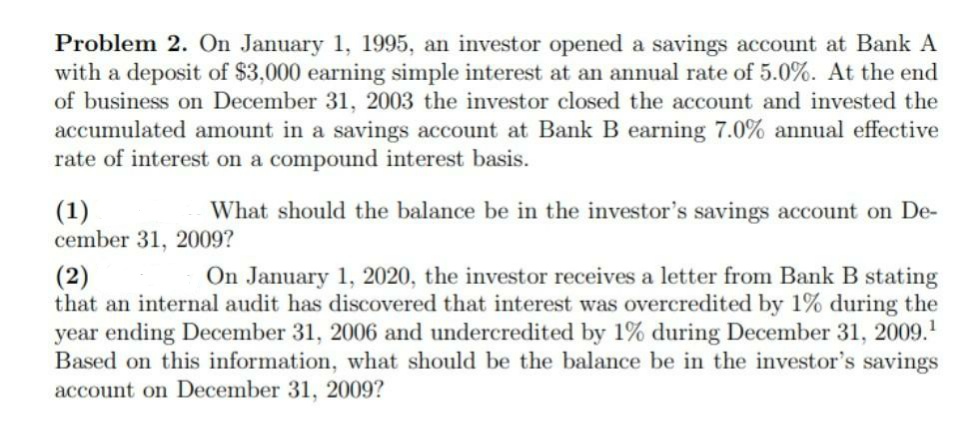Problem 2. On January 1, 1995, an investor opened a savings account at Bank A with a deposit of $3,000 earning simple interest at an annual rate of 5.0%. At the end of business on December 31, 2003 the investor closed the account and invested the accumulated amount in a savings account at Bank B earning 7.0% annual effective rate of interest on a compound interest basis. (1) What should the balance be in the investor's savings account on De- cember 31, 2009? (2) On January 1, 2020, the investor receives a letter from Bank B stating that an internal audit has discovered that interest was overcredited by 1% during the year ending December 31, 2006 and undercredited by 1% during December 31, 2009.¹ Based on this information, what should be the balance be in the investor's savings account on December 31, 2009?
Problem 2. On January 1, 1995, an investor opened a savings account at Bank A with a deposit of $3,000 earning simple interest at an annual rate of 5.0%. At the end of business on December 31, 2003 the investor closed the account and invested the accumulated amount in a savings account at Bank B earning 7.0% annual effective rate of interest on a compound interest basis. (1) What should the balance be in the investor's savings account on De- cember 31, 2009? (2) On January 1, 2020, the investor receives a letter from Bank B stating that an internal audit has discovered that interest was overcredited by 1% during the year ending December 31, 2006 and undercredited by 1% during December 31, 2009.¹ Based on this information, what should be the balance be in the investor's savings account on December 31, 2009?
Cornerstones of Financial Accounting
4th Edition
ISBN:9781337690881
Author:Jay Rich, Jeff Jones
Publisher:Jay Rich, Jeff Jones
ChapterA3: Time Value Of Money
Section: Chapter Questions
Problem 15E
Related questions
Question

Transcribed Image Text:Problem 2. On January 1, 1995, an investor opened a savings account at Bank A
with a deposit of $3,000 earning simple interest at an annual rate of 5.0%. At the end
of business on December 31, 2003 the investor closed the account and invested the
accumulated amount in a savings account at Bank B earning 7.0% annual effective
rate of interest on a compound interest basis.
(1)
What should the balance be in the investor's savings account on De-
cember 31, 2009?
(2)
On January 1, 2020, the investor receives a letter from Bank B stating
that an internal audit has discovered that interest was overcredited by 1% during the
year ending December 31, 2006 and undercredited by 1% during December 31, 2009.¹
Based on this information, what should be the balance be in the investor's savings
account on December 31, 2009?
Expert Solution
This question has been solved!
Explore an expertly crafted, step-by-step solution for a thorough understanding of key concepts.
Step by step
Solved in 4 steps

Recommended textbooks for you

Cornerstones of Financial Accounting
Accounting
ISBN:
9781337690881
Author:
Jay Rich, Jeff Jones
Publisher:
Cengage Learning

Financial Accounting: The Impact on Decision Make…
Accounting
ISBN:
9781305654174
Author:
Gary A. Porter, Curtis L. Norton
Publisher:
Cengage Learning

Principles of Accounting Volume 1
Accounting
ISBN:
9781947172685
Author:
OpenStax
Publisher:
OpenStax College

Cornerstones of Financial Accounting
Accounting
ISBN:
9781337690881
Author:
Jay Rich, Jeff Jones
Publisher:
Cengage Learning

Financial Accounting: The Impact on Decision Make…
Accounting
ISBN:
9781305654174
Author:
Gary A. Porter, Curtis L. Norton
Publisher:
Cengage Learning

Principles of Accounting Volume 1
Accounting
ISBN:
9781947172685
Author:
OpenStax
Publisher:
OpenStax College

Fundamentals Of Financial Management, Concise Edi…
Finance
ISBN:
9781337902571
Author:
Eugene F. Brigham, Joel F. Houston
Publisher:
Cengage Learning

Fundamentals of Financial Management (MindTap Cou…
Finance
ISBN:
9781337395250
Author:
Eugene F. Brigham, Joel F. Houston
Publisher:
Cengage Learning

Fundamentals of Financial Management, Concise Edi…
Finance
ISBN:
9781305635937
Author:
Eugene F. Brigham, Joel F. Houston
Publisher:
Cengage Learning